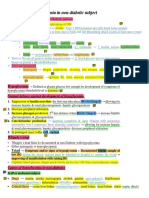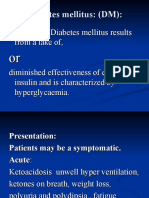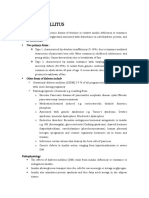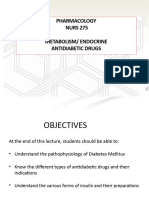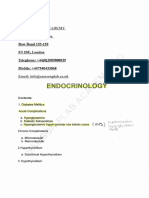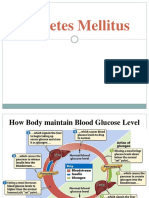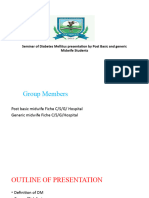0 ratings0% found this document useful (0 votes)
24 viewsHypoglycemia
Hypoglycemia
Uploaded by
mohamed mowafeyHypoglycemia in non-diabetic patients can have various causes, including certain drugs, critical illnesses affecting the liver or kidneys, and hormonal deficiencies. The hallmark of hypoglycemia is Whipple's triad: symptoms of low blood sugar, a measured low blood glucose level, and relief of symptoms with raising the glucose level. Diagnostic tests include fasting challenges in hospital to provoke hypoglycemia and measure hormones. Treatment depends on the underlying cause, such as surgery for insulinoma tumors or hormone replacement for deficiencies.
Copyright:
© All Rights Reserved
Available Formats
Download as PDF, TXT or read online from Scribd
Hypoglycemia
Hypoglycemia
Uploaded by
mohamed mowafey0 ratings0% found this document useful (0 votes)
24 views3 pagesHypoglycemia in non-diabetic patients can have various causes, including certain drugs, critical illnesses affecting the liver or kidneys, and hormonal deficiencies. The hallmark of hypoglycemia is Whipple's triad: symptoms of low blood sugar, a measured low blood glucose level, and relief of symptoms with raising the glucose level. Diagnostic tests include fasting challenges in hospital to provoke hypoglycemia and measure hormones. Treatment depends on the underlying cause, such as surgery for insulinoma tumors or hormone replacement for deficiencies.
Original Description:
Hypoglycemia for pregraduate medical students
Copyright
© © All Rights Reserved
Available Formats
PDF, TXT or read online from Scribd
Share this document
Did you find this document useful?
Is this content inappropriate?
Hypoglycemia in non-diabetic patients can have various causes, including certain drugs, critical illnesses affecting the liver or kidneys, and hormonal deficiencies. The hallmark of hypoglycemia is Whipple's triad: symptoms of low blood sugar, a measured low blood glucose level, and relief of symptoms with raising the glucose level. Diagnostic tests include fasting challenges in hospital to provoke hypoglycemia and measure hormones. Treatment depends on the underlying cause, such as surgery for insulinoma tumors or hormone replacement for deficiencies.
Copyright:
© All Rights Reserved
Available Formats
Download as PDF, TXT or read online from Scribd
Download as pdf or txt
0 ratings0% found this document useful (0 votes)
24 views3 pagesHypoglycemia
Hypoglycemia
Uploaded by
mohamed mowafeyHypoglycemia in non-diabetic patients can have various causes, including certain drugs, critical illnesses affecting the liver or kidneys, and hormonal deficiencies. The hallmark of hypoglycemia is Whipple's triad: symptoms of low blood sugar, a measured low blood glucose level, and relief of symptoms with raising the glucose level. Diagnostic tests include fasting challenges in hospital to provoke hypoglycemia and measure hormones. Treatment depends on the underlying cause, such as surgery for insulinoma tumors or hormone replacement for deficiencies.
Copyright:
© All Rights Reserved
Available Formats
Download as PDF, TXT or read online from Scribd
Download as pdf or txt
You are on page 1of 3
Hypoglycemia in non-diabetic subject
Quick Review of hypoglycemia in Diabetic patients
✓ Considered one of the acute complications of DM
✓ More common in type 1 DM due to insulin (Type 1 DM treatment specially basal bolus insulin)
(attack of various degrees occurs at least once a week and life-threatening attack occurs at least once a year)
✓ Causes
• Disharmony between meals or exertion and insulin
• Stress, acute illness, renal impairment (↓↓ insulinase → ↑ insulin action), hypothyroidism
• Drugs → secretagogues (sulfonylurea and meglitinides)
✓ There is No cut off point to define hypoglycemia → ↓↓ blood glucose up to manifestations
based on patient’s threshold/tolerance
✓ Signs and Symptoms
• Neurogenic → fatigue, palpitations, sweating, fine tremors, cold extremities, nervousness, pale
• Neuroglycopenic →agitation, fits, coma, amnesia, permanent brain damage
Hypoglycemia → Defined as plasma glucose low enough for development of symptoms of
hypoglycemia (threshold level is dynamic)
Normal defense against development of hypoglycemia:
1. Suppression of insulin secretion: the first step take place (BG 80-85mg/dl) →allowing for
increase hepatic & renal gluconeogenesis, hepatic glycogenolysis
2. Decrease peripheral utilization.
3. Increase glucagon production: 2nd line defense (when BG 65-70mg/dl) → increase hepatic
gluconeogenesis & glycogenolysis.
4. Catecholamine production → alarming symptoms & signs (Patient with autonomic
neuropathy won’t experience these alarming symptoms) → allowing for increase hepatic
& renal gluconeogenesis, hepatic glycogenolysis, decrease peripheral utilization.
5. In prolonged cases (>4h): GH, cortisol.
Whipple's triad of manifestation with raising BG
• Whipple’s triad Must be documented in non-Diabetic with hypoglycemia
• Either neurogenic or neuroglycopenic
• Triad → Symptoms and/or signs of hypoglycemia + Documented venous sample of
low BG during the attack (patient must be admitted to hospital to capture the event) +
improving of manifestation with raising BG
• Capillary blood glucose (finger-prick) levels are less by 10% than venous/plasma sample
Causes of hypoglycemia in non-diabetics
A) In ill or medicated subject
• Drugs → insulin, insulin secretagogue, alcohol, quinine (anti-malarial), Gatifloxacin
(respiratory quinolones), indomethacin (NSAIDs), pentamidine (anti-parasitic)
• Critical illness → acute liver failure (fulminant hepatitis), renal failure, heart failure, sepsis (septic shock)
• Hormonal deficiency → Glucagon, catecholamines(epi and nore), Cortisol (Addisons disease,
hypopituitarism)
• Tumors other than insulinoma → (Paraneoplastic syndrome → endocrinal and neurological
manifestations) SCC – small cell carcinoma or oat cell carcinoma of the lungs, hepatoma,
sarcomas → tumor cells release substances that act like insulin e.g., Insulin like growth
factor 2
B) In seeming well subject
• Insulinoma (rare) → may be sporadic or part of familial syndromes e.g., MEN-1
• Functional B-cells disorders (very difficult to diagnose) → post gastric bypass (dumping
syndrome), non-insulinoma pancreatogenous hypoglycemia, in children due to genetic
disturbances
• Auto immune hypoglycemia (Hirata Syndrome) → autoantibodies stimulating B-cells to
secrete insulin
• Factitious hypoglycemia (pretending to be ill for the sake of attention → Munchausen
Syndrome) → excluded by sulphonylurea testing in urine if induced by oral hypoglycemic
drug. If induced by insulin, it’s difficult to be detected
Fasting hypoglycemia
The symptoms of fasting hypoglycemia occur several hours after food (e.g., on waking or at
night) or can be precipitated by exercise
Causes:
• Drugs (insulin, sulphonylurea, quinine, salicylates, alcohol)
• Beta cell functional hyperplasia
• Insulinoma. (Incidence 1-2 /million, mostly single, benign, <2cm, may be familial)
• Organ Failure (acute fulminant hepatitis, CRF)
• Hormone deficiency (Addison’s disease, hypopituitarism)
• Non-islet cell tumors (fibrosarcoma, hepatocellular carcinoma, mesothelioma): IGFII
mediated.
• Autoimmune (insulin receptor-stimulating antibodies)
• Infection (septicemia, malaria)
• Inborn errors of metabolism (glycogen storage disease)
Postprandial hypoglycemia: Symptoms usually occur 2–5 hours after food.
• Alcohol
• Overweight & obese with insulin resistance (common) → reactive hypoglycemia due to ↑↑
insulin and ↓↓ glucagon + impaired fasting hyperglycemia → weight loss is the main
treatment to break the vicious cycle
• Late dumping syndrome. (common)
• Inborn errors of metabolism (hereditary fructose intolerance, maple syrup disease)
1.
Approach to a case of hypoglycemia (after sure documentation)
2. Test for circulating oral hypoglycemic agents → to exclude factitious hypoglycemia
3. For patient with fasting hypoglycemia: perform 72h fasting test in hospitalized closely
observed patient
4. For patient with postprandial hypoglycemia: perform mixed meal challenge in
hospitalized closely observed patient
The test end after documentation of hypoglycemia with assessment of insulin, proinsulin, c-peptide
4. Localizing images: Once diagnosis of endogenous hyperinsulinemia as a cause of
hypoglycemia. Dual phases CT, MRI with gadolinium enhancement, US, endoscopic
sonography, somatostatin receptor scintigraphy.
Management:
Immediate (emergency – ABCDE):
• Oral glucose as simple table sugar (the best) or fruit juice. Rule of 15 → give 15g (3
spoons) and measure blood glucose every 15 minutes. If not available give sugary fruit
juices. Chocolates are better avoided due to their contents of fats which impair & delay
intestinal glucose absorption. Glucose gel and tablets (sublingual) may be used (not
available)
• For those with impaired consciousness: IV dextrose 25% 100 ml (25 gm glucose), followed
by glucose infusion 5% or 10 %.
• IM or SC glucagon (1mg) (not available)
• Person with recurrent attacks should have medical ID or wearing bracelets.
Non-pharmacological:
• In fasting cases: frequent day time meals with large amount of uncooked starch at bedtime,
or even overnight glucose infusion.
• In dumping: small frequent meals with avoiding simple sugars.
Cause management:
• Insulinoma
✓ Surgery is the treatment of choice.
✓ Medical: Diazoxide, verapamil, Octreotide (somatostatin receptor analogue)
• Post gastric bypass & Functional islet hyperplasia: frequent feeding, α-glucosidase
inhibitor, diazoxide, or octreotide. (Partial pancreatectomy may be required)
• Replacement of deficient hormones.
• Steroid, immunosuppressive for autoimmune cases.
• Treatment of critical illness.
You might also like
- Approach To HypoglycemiaDocument37 pagesApproach To HypoglycemiaMiswar Abdul HalimNo ratings yet
- Anti Diabetic DrugsDocument58 pagesAnti Diabetic DrugsDaniel Wang100% (1)
- Naplex Complete Study Outline A Topic-Wise Approach DiabetesFrom EverandNaplex Complete Study Outline A Topic-Wise Approach DiabetesRating: 4 out of 5 stars4/5 (3)
- Nursing Care Plan (Post Op Exlap)Document2 pagesNursing Care Plan (Post Op Exlap)Kay D. Beredo100% (2)
- HypoglycemiaDocument3 pagesHypoglycemiamohamed mowafeyNo ratings yet
- Insulin and HypoglycemiaDocument39 pagesInsulin and Hypoglycemiao30285619No ratings yet
- Hypoglycemia UMYDocument60 pagesHypoglycemia UMYTommy AkromaNo ratings yet
- E SystemDocument81 pagesE SystemErsido SamuelNo ratings yet
- Hypoglycemia and HyperglycemiaDocument24 pagesHypoglycemia and HyperglycemiaNarayan GhimireNo ratings yet
- 5 Approach To HypoglycemiaDocument46 pages5 Approach To Hypoglycemiahamzatrad949No ratings yet
- AntidiabeticsDocument53 pagesAntidiabeticsFreda MorganNo ratings yet
- Diabetes Mellitus: - ClassificationDocument22 pagesDiabetes Mellitus: - ClassificationFernando Junior Parra UchasaraNo ratings yet
- HypoglycemiaDocument42 pagesHypoglycemiaseem neemNo ratings yet
- CP2 MidtermsDocument278 pagesCP2 MidtermsDiana WadwasinNo ratings yet
- Diabetes Mellitus: Risks FactorsDocument5 pagesDiabetes Mellitus: Risks FactorsAmer Abdulla SachitNo ratings yet
- Hypoglycemia: Yeditepe University Medical Faculty Department of Endocrinology and MetabolismDocument47 pagesHypoglycemia: Yeditepe University Medical Faculty Department of Endocrinology and MetabolismnawarajNo ratings yet
- Diabetes Mellitus 2Document8 pagesDiabetes Mellitus 2devanshipadh9No ratings yet
- Course 4 2019 Hypoglicemia HyperuricemiaDocument57 pagesCourse 4 2019 Hypoglicemia HyperuricemiaAmelia PricopNo ratings yet
- Hypoglycaemia: Presented by Undie, Malipeh-Unim U. House OfficerDocument39 pagesHypoglycaemia: Presented by Undie, Malipeh-Unim U. House OfficerAipee UndieNo ratings yet
- Diabetes MellituspptxDocument69 pagesDiabetes Mellituspptxnuguitnorelyn30No ratings yet
- HypoglycemiaDocument68 pagesHypoglycemialiaputranti100% (3)
- Diabetes Mellitus Type 1Document19 pagesDiabetes Mellitus Type 1QwertyNo ratings yet
- Acute Complications of Diabetes Mellitus: Hypoglycemia and Hypoglycemic ComaDocument30 pagesAcute Complications of Diabetes Mellitus: Hypoglycemia and Hypoglycemic ComaCristinaGheorgheNo ratings yet
- Blood GlucoseDocument8 pagesBlood Glucoseعبدالرحمن عابدNo ratings yet
- DM RecentDocument48 pagesDM RecentMuhammad Makki100% (1)
- Hypoglycemia: 8 TermDocument44 pagesHypoglycemia: 8 Termswathi bsNo ratings yet
- anaes&DMDocument11 pagesanaes&DMMohamed Satti AbdalsadigNo ratings yet
- Type 1 Diabetes MellitusDocument55 pagesType 1 Diabetes MellitusAidos BolatovNo ratings yet
- Pathophysiology and Management of Diabetes Mellitus GppqeDocument60 pagesPathophysiology and Management of Diabetes Mellitus GppqeOlivia OliverNo ratings yet
- DIABETIC COMA - Clinical Features and ManagementDocument54 pagesDIABETIC COMA - Clinical Features and ManagementRitesh SinghNo ratings yet
- Antidiabetic DrugsDocument53 pagesAntidiabetic Drugszmr27146No ratings yet
- Diabetes Mellitus: Ma. Tosca Cybil A. Torres, RN, ManDocument66 pagesDiabetes Mellitus: Ma. Tosca Cybil A. Torres, RN, ManyuliNo ratings yet
- Diabetes Mellitus: Ma. Tosca Cybil A. Torres, RN, ManDocument66 pagesDiabetes Mellitus: Ma. Tosca Cybil A. Torres, RN, ManNora Budina Abdinesia RitongaNo ratings yet
- Diabetes Mellitus: (DM)Document84 pagesDiabetes Mellitus: (DM)Andika HNo ratings yet
- Endocrine EmergenciesDocument86 pagesEndocrine Emergenciesadamu mohammadNo ratings yet
- Diabetes Mellitus LectureDocument68 pagesDiabetes Mellitus LectureDikyAksiramNo ratings yet
- Endocrine Disorders-1Document52 pagesEndocrine Disorders-1Nathaniel Mbiu TimNo ratings yet
- Diabetes Mellitus: Salient Features of Type 1 Am D Type 2 DMDocument20 pagesDiabetes Mellitus: Salient Features of Type 1 Am D Type 2 DMPriyanka Karnik100% (1)
- Lecture16 Anti Diabetic DrugsDocument61 pagesLecture16 Anti Diabetic Drugsharis.18No ratings yet
- Module 08 - Endocrine DisordersDocument43 pagesModule 08 - Endocrine DisordersKarina LojaNo ratings yet
- UNIT - IV Endocrine Diseases, Sub Unit 4.2 Diabetes Mellitus - Etiology and Pathogenesis of Diabetes - Clinical Manifestations of The Disease - Management of The Disease - Complications of Diabetes.Document40 pagesUNIT - IV Endocrine Diseases, Sub Unit 4.2 Diabetes Mellitus - Etiology and Pathogenesis of Diabetes - Clinical Manifestations of The Disease - Management of The Disease - Complications of Diabetes.reza dehghaniNo ratings yet
- Diabetes Mellitus (Updated Lec Notes - March 2022)Document40 pagesDiabetes Mellitus (Updated Lec Notes - March 2022)Saketh Varma PakalapatiNo ratings yet
- Endocrinology 3Document56 pagesEndocrinology 3Wonjoo LeeNo ratings yet
- Diabetes Mellitus-Insulin 9-19-18 Student VersDocument57 pagesDiabetes Mellitus-Insulin 9-19-18 Student VersJavier GonzalezNo ratings yet
- Diabetes Millitus PDFDocument41 pagesDiabetes Millitus PDFAbdullah BhattiNo ratings yet
- Drugs and The Endocrine System: Treatment of Diabetes MellitusDocument108 pagesDrugs and The Endocrine System: Treatment of Diabetes MellitusPnpplorangeNo ratings yet
- Diabetes Mellitus: Ma. Tosca Cybil A. Torres, RN, ManDocument66 pagesDiabetes Mellitus: Ma. Tosca Cybil A. Torres, RN, ManElvis J. DavisNo ratings yet
- Dental Management of Patients With Diabetes MellitusDocument8 pagesDental Management of Patients With Diabetes Mellitusاحمد سلامNo ratings yet
- Endocrine EmergencyDocument24 pagesEndocrine EmergencymalarmathiNo ratings yet
- 06 - 224diagnosis Dan Tatalaksana Meningitis BakterialisDocument10 pages06 - 224diagnosis Dan Tatalaksana Meningitis BakterialisMjn BausatNo ratings yet
- Diabetes 2023Document18 pagesDiabetes 2023o.aderetiNo ratings yet
- Welcome To The PresentationDocument32 pagesWelcome To The PresentationIshaan Arfatur Rahman0% (1)
- Diabetes Mellitus CDocument48 pagesDiabetes Mellitus Cjoel david knda mjNo ratings yet
- بحث سلمانDocument42 pagesبحث سلمانZaraki yamiNo ratings yet
- Antidiabetic DrugsDocument68 pagesAntidiabetic DrugsninetysevenccNo ratings yet
- Childhood Diabetes 2016Document64 pagesChildhood Diabetes 2016Awatef AbushhiwaNo ratings yet
- Paeda DMDocument38 pagesPaeda DMAmanuel LemiNo ratings yet
- DM Presentation NewDocument44 pagesDM Presentation NewKipz JonsNo ratings yet
- Diabetes and It's Oral ManifestationsDocument28 pagesDiabetes and It's Oral ManifestationsYashpreetsingh BhatiaNo ratings yet
- L11 Diabetes MellitusDocument61 pagesL11 Diabetes MellitusYosra —No ratings yet
- DiabetesmellitusDocument24 pagesDiabetesmellitusSania SaeedNo ratings yet
- 200 MCQs - FINANCIAL MARKETS AND OPERATIONSDocument22 pages200 MCQs - FINANCIAL MARKETS AND OPERATIONSmohamed mowafeyNo ratings yet
- 885 MCQs - IPCDocument181 pages885 MCQs - IPCmohamed mowafeyNo ratings yet
- 600 MCQs - CPC KAMKUSDocument102 pages600 MCQs - CPC KAMKUSmohamed mowafeyNo ratings yet
- 50 MCQs - LAND LAWS MAHARASTRADocument20 pages50 MCQs - LAND LAWS MAHARASTRAmohamed mowafeyNo ratings yet
- 64 MCQs - SEBIDocument19 pages64 MCQs - SEBImohamed mowafeyNo ratings yet
- MCQ HTNDocument18 pagesMCQ HTNmohamed mowafeyNo ratings yet
- 30 MCQs - Capital Market and SecuritiesDocument9 pages30 MCQs - Capital Market and Securitiesmohamed mowafeyNo ratings yet
- ORAL Internal MedicineDocument4 pagesORAL Internal Medicinemohamed mowafeyNo ratings yet
- JaundiceDocument5 pagesJaundicemohamed mowafeyNo ratings yet
- Prelim Exam 22-23 DSBDADocument2 pagesPrelim Exam 22-23 DSBDAmohamed mowafeyNo ratings yet
- HemochromatosisDocument6 pagesHemochromatosismohamed mowafeyNo ratings yet
- 16 MCQs - MUSLIM LAWDocument2 pages16 MCQs - MUSLIM LAWmohamed mowafeyNo ratings yet
- 2 - MCQ 2 DoneDocument9 pages2 - MCQ 2 Donemohamed mowafeyNo ratings yet
- 1.3 - MCQ 1 DoneDocument7 pages1.3 - MCQ 1 Donemohamed mowafeyNo ratings yet
- Erectile DysfunctionDocument9 pagesErectile Dysfunctionmohamed mowafeyNo ratings yet
- DiarrheaDocument5 pagesDiarrheamohamed mowafeyNo ratings yet
- MCQ Internal MedicineDocument16 pagesMCQ Internal Medicinemohamed mowafey100% (2)
- FlukesDocument1 pageFlukesmohamed mowafeyNo ratings yet
- OSCE Internal MedicineDocument4 pagesOSCE Internal Medicinemohamed mowafeyNo ratings yet
- OSCE Internal Medicine2Document4 pagesOSCE Internal Medicine2mohamed mowafeyNo ratings yet
- Peri-Arrest ArrythmiaDocument14 pagesPeri-Arrest Arrythmiamohamed mowafeyNo ratings yet
- MCQs OrthoDocument87 pagesMCQs Orthomohamed mowafeyNo ratings yet
- Anatomy Questions Hip and ThighDocument11 pagesAnatomy Questions Hip and Thighmohamed mowafeyNo ratings yet
- Diabetic KetoacidosisDocument85 pagesDiabetic Ketoacidosismohamed mowafeyNo ratings yet
- Oa OsteoaethritisDocument30 pagesOa Osteoaethritismohamed mowafeyNo ratings yet
- NRPDocument15 pagesNRPmohamed mowafeyNo ratings yet
- The Neonate at 24 To 48 Hours Following Early DischargeDocument8 pagesThe Neonate at 24 To 48 Hours Following Early Dischargenursereview100% (2)
- XP0318Document2 pagesXP0318sanggau.kocakNo ratings yet
- Premature EjaculationDocument35 pagesPremature EjaculationGracen33No ratings yet
- MalariaDocument51 pagesMalariaGeremew TesfayeNo ratings yet
- Slide Ercp 29 MARET 2019Document92 pagesSlide Ercp 29 MARET 2019ariceghaNo ratings yet
- Multiple MylomaDocument14 pagesMultiple MylomaRadison sierraNo ratings yet
- Oral Aspects of Metabolic DiseasesDocument39 pagesOral Aspects of Metabolic DiseasesriyaNo ratings yet
- Lanas, 2014Document5 pagesLanas, 2014ValentinaNo ratings yet
- Sdbiosensor Insert F D DimerDocument2 pagesSdbiosensor Insert F D DimerEmi SoubaiNo ratings yet
- Binocular Vision & Orthoptics - Bruce Evans - 17Document3 pagesBinocular Vision & Orthoptics - Bruce Evans - 17Danielle Sangalang0% (1)
- Description of Modes AvailableDocument7 pagesDescription of Modes AvailableJenn TNo ratings yet
- Amniotic Fluid EmbolismDocument26 pagesAmniotic Fluid EmbolismAnant PachisiaNo ratings yet
- Symptomatic Vulvar Demodicosis: A Case Report and Review of The LiteratureDocument4 pagesSymptomatic Vulvar Demodicosis: A Case Report and Review of The LiteratureSilvia Yin CM100% (1)
- Rubella Elisa Igm CaptureDocument4 pagesRubella Elisa Igm Capturehabib alfahmiNo ratings yet
- ECHO Autism: A New Model For Training Primary Care Providers in Best-Practice Care For Children With AutismDocument10 pagesECHO Autism: A New Model For Training Primary Care Providers in Best-Practice Care For Children With AutismCha AgniswariNo ratings yet
- Immunology MCQ BY: Dr. AlgassimDocument4 pagesImmunology MCQ BY: Dr. AlgassimmohamedNo ratings yet
- NCLEX Based 1000 MCQs Part-2Document12 pagesNCLEX Based 1000 MCQs Part-2AkashNo ratings yet
- Type of IncisionsDocument2 pagesType of Incisionsdemoniac1420100% (4)
- Nerve Conduction Velocity StudiesDocument12 pagesNerve Conduction Velocity StudiessridharNo ratings yet
- Nhis Drug Price List Final (2013 Ed)Document32 pagesNhis Drug Price List Final (2013 Ed)holuwadamilare935No ratings yet
- Cardio1 PDFDocument7 pagesCardio1 PDFAyu SuprabawatiNo ratings yet
- UBC SC-IM Parenteral Ketamine Protocol FinalDocument14 pagesUBC SC-IM Parenteral Ketamine Protocol FinalGolden Trade Ideas 32No ratings yet
- Code Blue PresentationDocument22 pagesCode Blue PresentationNurhayatiNo ratings yet
- X GuideNavigationModelAccuracyJOI10.16Document7 pagesX GuideNavigationModelAccuracyJOI10.16Mrinmayee ThakurNo ratings yet
- Discussion Paper On 3 Ply Mask UV Sterilization ChamberDocument4 pagesDiscussion Paper On 3 Ply Mask UV Sterilization ChamberazalinaNo ratings yet
- Reproductive Health: Salvador P. Llavore, RM, RN, LPT, MancDocument109 pagesReproductive Health: Salvador P. Llavore, RM, RN, LPT, Mancmalinda100% (1)
- GESTASIONAL DIABETES MELLITUS SimposiumDocument18 pagesGESTASIONAL DIABETES MELLITUS SimposiumHabiby Habibaty QolbiNo ratings yet
- Past Paper - 221208 - 003047Document96 pagesPast Paper - 221208 - 003047Ashraf ShalbiNo ratings yet
- Kode ICD 10 Kasus ObsgynDocument2 pagesKode ICD 10 Kasus ObsgynKathleen MartinezNo ratings yet




